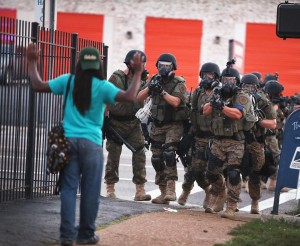We have a dream. That one day, racism won’t be so freighted with euphemism

Tear gas and rubber bullets are pressed into use as residents of Ferguson, MO protest the shooting by police of unarmed black teenager Michael Brown
“The United States of America is not for black people,” Greg Howard wrote in The Concourse, a few days before the police in Ferguson, Missouri, linked dead teenager #MichaelBrown with alleged shoplifting.
Mr Howard proceeded to explain that America’s militarized police force is no longer able to protect and serve. Instead, it’s committed to searching and destroying. And unarmed black men like Michael Brown fall victim to the tendency to search out and destroy “danger”.
Mr Howard wrote, “The worst part of outfitting our police officers as soldiers has been psychological. Give a man access to drones, tanks, and body armor, and he’ll reasonably think that his job isn’t simply to maintain peace, but to eradicate danger. Instead of protecting and serving, police are searching and destroying.”
He’s not wrong though it’s hard to suspend judgment to the point that you can believe “America is not for black people”.
We’ve been here before. Over and over.
Last September, in a comment piece for an Indian paper, I felt it was important to explain to non-American readers that the facts about racism and popular perception of it are too entangled for rational discourse. First, one has to disentangle the strands.
So what are the facts about race in America?
There’s a black man in the White House. That’s indisputably an advance and we should not forget, despite the deaths of Michael Brown and Trayvon Martin (in February 2013) and countless others who were “living while black”.
Despite everything, America 2014 is very different from back in the 1950s. Then, the equality of man envisioned by the Declaration of Independence was far from a reality, interracial marriage was illegal in many states and housing and education segregated.
A further fact about racism in America: Yes, profiling consistently picks on and picks out young black males.
And yes, they are more likely to be in trouble for a variety of reasons that include socio-economic and historical factors. Even Ta-Nehisi Coates, The Atlantic magazine’s African-American senior editor, rejects “racial profiling writ large” for himself, his 12-year-old son, nephews and other male family members, but concedes that “it would be senseless for the police to be stopping Danish tourists in Times Square just to make the statistics look good”. After all, says Coates, 78% of all shooting suspects in New York are black even though they make up just a quarter of the city’s population.
The issues are varied and complex – too much so for simple reflexive rhetoric. And easy unexplored perceptions. That’s how every young black man is rendered suspect. And journalists can fulminate that “America is not for black people”.
So to the dream. That one day, racism won’t be so freighted with euphemism – on all sides.
(Tomorrow: America’s militarized streets can’t fully explain #MichaelBrown’s death)

